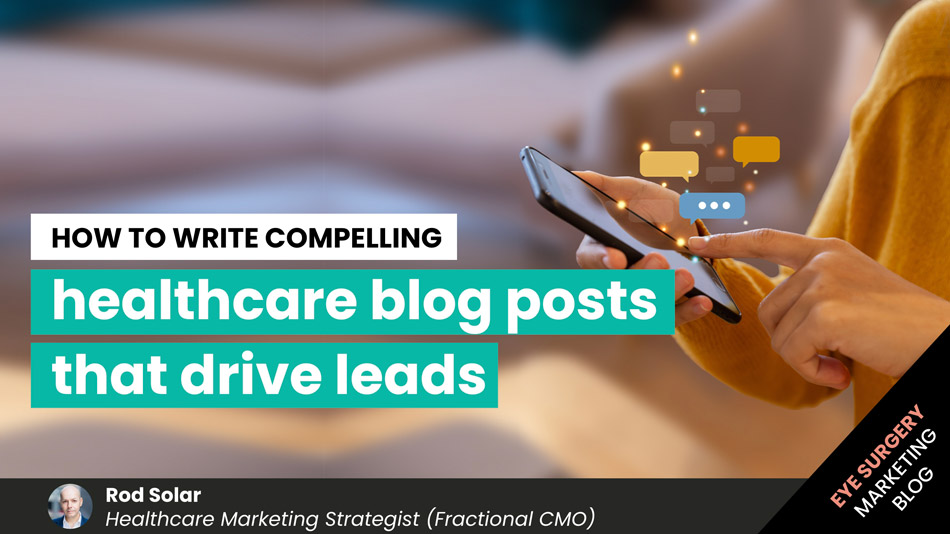
How to write compelling healthcare blog posts that drive leads
We know you’re busy and have no time to waste on writing healthcare blog posts if they don’t generate results. That’s why we’ve packed over 30 specific writing tips in this post to help you write compelling healthcare blog posts that drive leads to your clinic.
Writing website copy that keeps your prospect’s attention and interest is a crucial skill. The quality of your copywriting can mean the difference between a website bounce versus a website conversion.
After reading this post, you’ll have an easy-to-follow blueprint you can use to write compelling healthcare blog posts that produce qualified leads for your practice.
Does this sound like a good way to spend 5 minutes? Then, let’s get on with it!
Writing headlines to attract attention to healthcare blog posts
First, let’s look at the headline for this post. It caught your attention, right? How do we know? You wouldn’t be reading these words if it didn’t. That’s what you want your prospects to do – read your email or website headlines and then click on them!
That’s why your blog post headline is, arguably, the most important element of your copy. In fact, you should spend as much time writing headlines (and headers) as you spend writing the body copy.
Your blog post headline should:
- Be emotional
- Stir curiosity
- Usher in the rest of the copy
- Satisfy your prospect’s intent
- Address core beliefs the prospect has – their feelings, desires or insecurities
- Make an offer, if possible
- Be ultra-specific.
Writing a lede that speaks directly to your prospect’s after state
Your lede (yes, we spelt that right) is the one or two sentences that immediately follow the headline.
Your lede should allude to your prospect’s after state. An after state is what your prospect wants to have and feel, what they want their daily life to be like, and how they want to be perceived – after they consume your product or service. The after should be alluded to in the headline and supported by the body copy.
You need to be ultra clear on what the “after” of your ideal customer is. Knowing what your prospect wants after consuming your service is crucial. For now, let’s assume you know. (If you need clarity on this, give us a call and we’ll help you figure it out.)
The lede is where the prospect should see and feel the benefits of what you offer. In your lede, you need to:
- Answer the prospect’s unspoken question: “Why should I care?”
- Introduce the big idea contained in the page
- Set the thematic pace.
- Attempt to forge a connection between you and the prospect
- Build a story of what life would be like after the benefits of your service
Notice how we did that in the first few paragraphs immediately following the headline? If you are reading these words, the lede accomplished its task. Get your prospects to do the same by writing leads that usher them into your body copy.
With popular services like LASIK, we typically advise our clients to write ledes that assume the reader already knows what LASIK is, such as in this example:
“Experience freedom from glasses and contact lenses from just £35 a month.”
With less-known services like PRESBYOND, we advise our clients to assume the prospect is not aware of what the service can do – and focus the lede on the problem and solution, such as in this example:
“If you’re over 40, it’s possible to read small print again via an innovative reading vision treatment called PRESBYOND.”
Writing body copy that converts
Your body copy is your sales argument. You need to prove to your prospect that your solution (e.g. your service) is the one they need versus other solutions.
Your body copy should:
-
- Introduce the service. Don’t assume they know what it is. Spell it out
- Make and prove legitimate claims. Explain what your service has done and can do for your prospect
- Show the immediate and future benefits of your service – and then describe how the features of the service deliver the benefits
- Reinforce your Statement of Value. What do you specifically offer patients?
- Reinforce your Unique Selling Proposition – How do you differentiate yourself on patient priorities?
- Address the prospect’s Dominant Buying Motives – How might your service change what your prospect has, what they feel, how their daily life unfolds, or what kind of status they enjoy?
- Provide a way for your prospect to understand what you are offering – both in terms of your core service and also your online content. Do you offer more content to consume online? Do you offer a free information resource online – like a lead magnet? Do you have a free consultation they could benefit from?
- Introduce testimonials – How has your service helped people like your prospect?
- Supply proof, including:
- Testimonials that focus on one benefit (excerpt if you must)
- Outcome and patient satisfaction statistics
- Third-party or primary research
- Your credentials
- Images that show the benefits of taking action
- Before and after pictures showing what the prospect can see after they have your service
We suggest you place one, two or possibly more call-to-actions in the body copy, depending on the length of your copy. A good rule of thumb is to show one call-to-action per page scroll.
Closing your healthcare blog posts to move your reader to the next step
Your close should aim to remove any residual scepticism and replace it with a positive and expectant feeling about the relationship between you and your prospect.
Your healthcare blog posts should close to:
- Remind your reader what they get if they “ascend” to the next step in your sales pipeline (do you offer more content, a lead magnet, a tripwire? If you have no idea what these things are and how they can help you dramatically improve your lead generation results – let us know and we’ll give you a quick overview on the phone)
- Equate your service with the prospect’s desired results
- Restate your Unique Selling Proposition and Statement of Value.
Sprinkling calls-to-action that stimulate prospects to take action
A call-to-action is a stimulus to do something to achieve an aim or deal with a problem. You must, with your copy and other tools like graphics and buttons, induce the reader to perform a specific act, typically taking the form of an instruction or directive. Sprinkle your call-to-action liberally throughout your:
- Sales pages
- Blog posts
- Website sidebars
- Website header
- Website footer
- E-mail messages
- Ads
- Social media posts
- Exit offers
And any other communication, written or otherwise, that aims to get the prospect to do something.
And there you have it. You now have all the ingredients you need to cook up the best blog posts in your speciality.
Of course, writing good copy takes some time, and not everyone has it. If that describes you, then you might want us to write compelling healthcare blog posts (or edit your blog posts) for you. Either way, we know that by following the tips in this post you will generate more leads from your blog.
NOTE: The best way to answer that nagging question about practice growth or marketing or patient volume in the back of your mind is to book a free 15-minute compatibility call. Get some options and go away with a clear idea of what’s possible.
About the author

Rod Solar
Founder & Scalable Business Advisor / fCMO
Rod Solar is a co-founder of LiveseySolar and a Scalable Business Advisor for its customers. Rod mentors and coaches eye surgery business CEOs/Founders and their leadership teams to triple their sales, double their profit, and achieve their “ideal exit”.
Related Posts
Meet our Co-Founders
We’re passionate about helping leaders of high-quality, growth-minded practice owners double their practice revenue

Rod Solar
Founder & Scalable Business Advisor
For over 20 years, I’ve helped ophthalmology entrepreneurs scale their private practices. I specialise in doubling revenue within three years by offering a proven framework, hands-on experience, and a team of experts who implement what works. We take the guesswork out of growth and scale, so you can focus on delivering exceptional patient care while maximising the value of your business.
LiveseySolar completely transformed the way we were approaching this… We’ve gone from having just the dream of having a practice to having a practice up and running with people making inquiries and booking for procedures… It’s extremely pleasing. We feel lucky we connected with LiveseySolar.
— Dr Matthew Russell, MBChB, FRANZCO, specialist ophthalmic surgeon and founder of VSON and OKKO

Laura Livesey
Founder & CEO
I’m the co-founder & CEO of LiveseySolar. I’ve developed powerful eye surgery marketing systems that increase patient volumes and profits for doctors, clinics, and hospitals, since 1997.
Rod and Laura know as much about marketing surgery to patients as I know about performing it. They are an expert in the field of laser eye surgery marketing. They know this industry inside out. I believe that they could help many companies in a variety of areas including marketing materials, sales training and marketing support for doctors.
— Prof. Dan Reinstein, MD MA FRSC DABO, founder of the London Vision Clinic, UK











